The Palmetto Tree Service Difference
At Palmetto Tree Service, we believe that trees make the world a much more pleasant place to live. They provide us with refreshing shade, verdant beauty, cool shade, and emergency shelter. They add personality to our homes, raise our property values, and give us clean air to breathe. When your home is well-manicured, with healthy trees, everyone around benefits. That's why, as arborists, we are passionate about providing our customers with dependable Lowcountry tree care.
We believe that honest prices, state-of-the-art equipment, friendly arborists, and good old-fashioned hard work set us apart from our competition. With years of experience serving homeowners in South Carolina, you can rest easy knowing every member of our team is committed to:
- Conducting themselves in a professional manner
- Providing you with top-notch tree care services
- Arriving at your property on time and ready to work hard
- Providing you with reasonable tree care service rates
- Exceeding expectations
- Utilizing safe, time-tested techniques when trimming, pruning, or removing your trees and shrubs
- Friendly, helpful customer service
Our customers mean the world to us. When you hire our company for tree services in cityname, we take that responsibility seriously. No matter the size of your project, our team will always treat your home like it is our own. Plus, you won't ever have to worry about sneaky hidden fees or outrageous pricing. We believe every homeowner deserves access to affordable tree services!
Whether your home has overgrown trees that need trimming or you have unsightly stumps that require grinding, we're here to handle it all. Curious what kind of tree care we provide to homeowners in The Palmetto State?
Call Us
 843-345-0579
843-345-0579
Our Services
Services Area
Eco-Responsible Tree Removal in Charleston, SC
We have removed thousands of trees over the years. However, we never recommend tree removal if it's not warranted. Some South Carolina tree service companies tend to remove trees when they should be saved or simply pruned. Others go the opposite direction and never recommend tree removal.
Unlike other companies, our arborists make educated recommendations based on experience, your trees, and your needs. We make the right call for you - not for us. If disease, destruction of foundation, or other circumstances necessitate tree removal, rest assured we're recommending it for a reason.
Benefits of Tree Removal
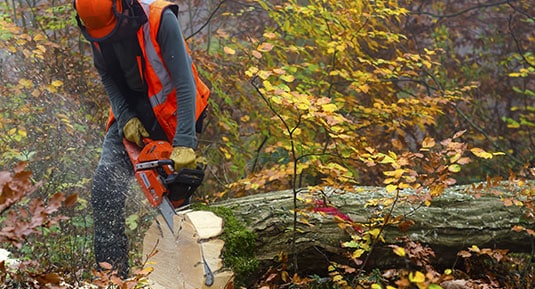

Though we never recommend this service unless it's needed, tree removal is often the only way to protect your property and family. When done properly, removing trees from your yard can have numerous benefits.

Prevent Damage to Your Foundation
When the roots of a tree spread and grow, they often damage concrete structures, like your home's foundation or driveway. This unsightly, unsafe situation is preventable with careful tree removal.

More Yard Space
If you've got to remove trees, you might as well make use of the space. Removing trees from your yard frees up space for fun, useful additions to your home firepits and pools. Some examples that we've seen from clients include removing more free space to plant vegetables and flowers and even room to build a new basketball court.

Enhanced Views
Another benefit of tree removal is that you can create a better view for your home, both inside and out. If you have unhealthy trees blocking the view of your property, removing the tree could be a solution. On the other side of the coin, you might want the exterior view of your home to remain intact and unobstructed by trees.
Tree Trimming in Charleston, SC
Have you noticed your favorite tree growing strangely? Are your trees so overgrown that it's making your home look like vagrants live there? Are the trees around your property weighed down by dead, dangerous branches? If you answered yes to any of those scenarios, Palmetto Tree Service has a solution to your problem.
Most folks don't know that trees respond to their environment. When trees aren't cared for, they can cause unwanted problems for the homeowner. Issues like overgrowth aren't just ugly - it's a potential safety hazard for your home and family. To prevent these problems from plaguing your property, it's important to keep your trees pruned and trimmed.
Our pruning and trimming have been described as "artistry" by our customers and are performed by highly skilled tree climbers per the Society of Arboriculture standards. Trimming procedures such as view enhancement and crown raising boosts curb appeal and open up obscured views. Proper pruning can also help establish your tree's structural integrity, which helps keep them planted firmly even in South Carolina wind gusts.
Because every shrub and tree is different, we approach our tree trimming projects with a detailed plan of action. That plan starts with our team of professional tree trimmers visiting your home. Once we see what kind of trees we'll be pruning or trimming, we'll put together an actionable plan which we'll share with you. As tree care specialists, we always account for unique variables like your tree's species and where they're located in your yard.

Benefits of Tree Trimming
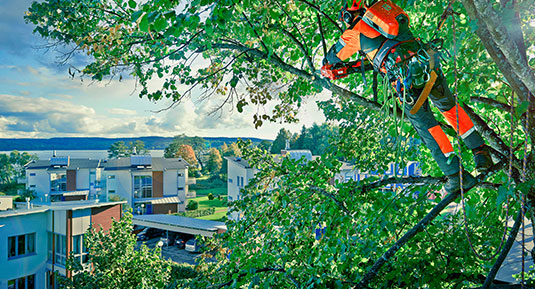
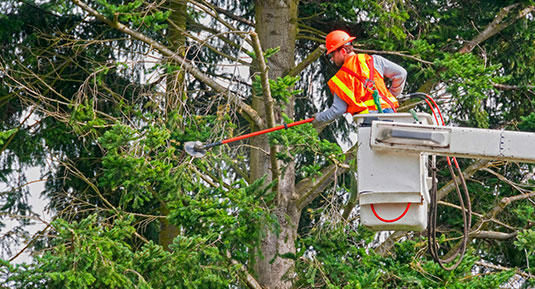
For some folks, tree trimming seems like a minor detail in the grand scheme of homeownership. It can be tedious, but keeping your trees trimmed and well-maintained is more important than you might think. Below are just a few of the many benefits of keeping your trees and shrubs trimmed:

Tree Health
Part of the Palmetto Tree Service pruning and trimming process includes the removal of damaged, broken, dead, and diseased branches. When ignored, these dead and dying branches grow harmful fungi that can decimate the trees around your home or business. Removing these branches can help keep your trees healthy. Tree trimming also allows the sun and air to reach your trees, further helping to maintain their health.

Safety
As proud residents of South Carolina, we know how scary lightning storms and hurricanes are. Strong winds from these natural disasters result in fallen branches and uprooted trees. South Carolina's storm season is a serious concern for homeowners, especially those with tree-lined driveways, rec areas, and walking paths. When you trust Palmetto Tree Service, you're actually storm-proofing your home. If you have low-hanging limbs near home, pruning provides more safety and overhead clearance. That way, you don't have a panic attack every time the skies open up.

Aesthetics
Nobody likes the looks of a dying, disheveled tree. Tree trimming improves the general appearance of your tree and makes your whole yard and home look better. Tree trimming also helps prevent branches from intertwining with one another.

Developmental Tree Trimming
Pruning younger trees is crucial for their health as they age. This vital tree service in Charleston keeps young trees appealing and helps promote optimal branch structure.
Types of Tree Trimming
Not all tree trimming services from Palmetto Tree are the same. Our experts specialize in many trimming services, so you get the right kind of trim for your needs. Our team understands that even the slightest mistake can permanently affect your yard and trees. That's why we approach every project with precision and expertise.
Crown Reduction: When your trees age without proper care, they can develop too many branches on their interior. Trees like this give great shade, but too much is not a good sign. That's where crown reduction trimming comes in. By reducing the density of your tree's crown, our tree care experts improve its growth rate and health. Crown density reduction also promotes a longer lifespan and a more beautiful appearance.
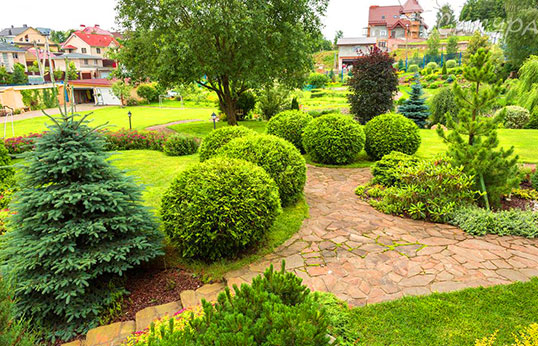
Storm Prep and Cleanup: Trimming and pruning procedures like removing dead wood and thinning crowns should be done before a major storm hits. Reducing branches and leaves lessens the force that wind gusts have and helps minimize the chances of trees falling. If a storm does damage your land, Palmetto Tree Service has the team and tools to help. Having recently worked Hurricanes Charlie, Ivan, Wilma, Katrina, Ike, Irene, Florence, Dorian, and even Sandy, Palmetto Tree Service has vast experience with twisted and fallen trees. We protect your property from further damage and safely remove lumber from damaged structures.
Other tree trimming services that Palmetto Tree Service offers include:
- Hazardous Tree Assessments
- Shrub Trimming
- Pruning
- Cabling
- Bracing
- Corrective Trimming
Contact Us
Free EstimateStump Grinding in Charleston, SC
For most property owners, removing a tree can seem like a major project. While that notion certainly isn't wrong, tree removal is more straightforward and often easier than trying to remove an unsightly stump from your yard. Have you ever wondered why you see so many yards with stumps dotted around the land? It's because they're tough to remove. That is why Palmetto Tree Service offers stump removal services in South Carolina.
Our skilled stump grinders bring a depth of knowledge and modern tools to every project we approach. Available for any tree removal project, our fast, efficient grinding machines ensure stumps are 6-8 inches below grade. That way, you can plant your favorite bushes and shrubs where your stump used to be.
Our stump grinding and removal efforts don't just make your yard look great. They also save you time, money, and can prevent injuries. There's a time and place for DIY yard work, but stump removal isn't one of them. Going the "DIY" route can take weeks, even if you work an hour or two every day. There's also the issue of operating heavy machinery on your own, which is dangerous and costly. For these reasons alone, it's best to trust professional stump grinders to remove your tree stumps safely.
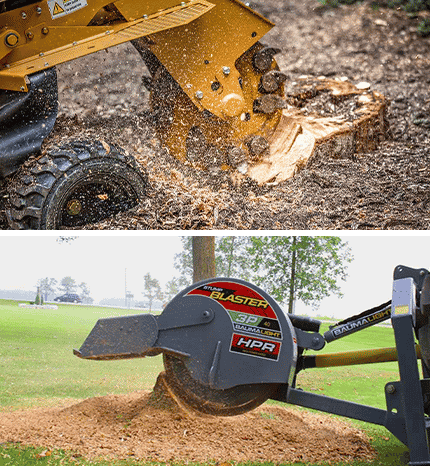
Benefits of Stump Removal in Charleston, SC
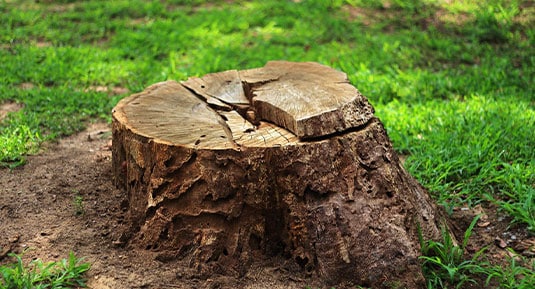


Pest Prevention
Tree stumps are notorious for harboring harmful pests that can ruin your property. We're talking ants, termites, carpenter bees, and other wood borers. If you've noticed an uptick in pests around your home, call Palmetto Tree Service for a quote on our stump removal. You could be killing two birds with one stone.

Eliminate Unwanted Growth
When you leave a tree stump in your yard, there's a good chance you could experience unwanted tree growth. These new growths cause clusters of small trees to grow at the base of your stump. This isn't only unsightly - it can kill nearby plants because the more recent growths hoard water and nutrients to themselves.

Better Looking Yard
If you're a homeowner who loves beautiful landscaping, well-sculpted hedges, and a neat law, you will love our stump removal services. Not just for the weight off your chest but for your home's enhanced curb appeal and resale value. This point is extra pertinent if you're going to sell your home soon.

More Space
If your yard is small, even one stump can affect your usable space. If you spend a lot of time playing sports or just enjoying your yard space, stump removal is a huge help. After all, nobody wants to toss a football if there are old stumps you've got to avoid. With their complicated root systems, stumps also take up considerable space below ground. Stump removal gives your family the space needed to grow vegies, plant flowers, erect water features, and more.

Reduce Headaches
Is stump removal impossible for non-professionals? Sure, in theory. You could take spend hours researching the best ways to remove stumps. You could go to your hardware store, rent a powerful stump grinder, and risk your safety trying to run it without training. You could spend every minute of your free time grinding the stump down. Or, you could work with a trustworthy stump removal company with trained professionals, as you'll find at Palmetto Tree Service.
Your Premier Tree Service Company in South Carolina
With years of experience, it's no wonder why so many South Carolina natives choose Palmetto Tree Service over the competition. Clients love us because we exceed expectations with a smile - no if's, and's, or but's.
Our commitment to superior service isn't a gimmick; it's a year-round promise. When you choose Palmetto Tree, you'll benefit from:
- Professional advice and expertise
- Seasoned, friendly, hardworking tree care experts
- Efficient, effective tree care services
- Competitive pricing
Ready to get started? We're ready to help! Give us a call to learn more about our tree care services and to schedule your first appointment today.
 843-345-0579
843-345-0579
Free Consultation
Latest News in Charleston, SC
Samford vs. Citadel January 6 Tickets & Start Time
Data Skrivehttps://www.wtvy.com/sports/betting/2024/01/06/samford-vs-citadel-buy-college-basketball-tickets/
Saturday's SoCon schedule includes the Citadel Bulldogs (7-5, 0-0 SoCon) versus the Samford Bulldogs (11-2, 0-0 SoCon) at 1:00 PM ET on ESPN+.If you're looking to attend this game in person, head to Ticketmaster to buy your tickets!Samford vs. Citadel Game InformationWatch college basketball, other live sports and more on Fubo! ...
Saturday's SoCon schedule includes the Citadel Bulldogs (7-5, 0-0 SoCon) versus the Samford Bulldogs (11-2, 0-0 SoCon) at 1:00 PM ET on ESPN+.
If you're looking to attend this game in person, head to Ticketmaster to buy your tickets!
Samford vs. Citadel Game Information
Watch college basketball, other live sports and more on Fubo! Use our link to sign up for a free trial.
Buy Tickets for Other Samford Games
Rep your team with officially licensed college basketball gear! Head to Fanatics to find jerseys, shirts, and much more.
Samford Players to Watch
Catch college basketball action all season long on Fubo!
Citadel Players to Watch
Sportsbook Promo Codes
Samford vs. Citadel Stat Comparison
Not all offers available in all states, please visit BetMGM for the latest promotions for your area. Must be 21+ to gamble, please wager responsibly. If you or someone you know has a gambling problem, contact 1-800-GAMBLER.
Bringing back an old favorite: Iconic Charleston brand Luden’s reintroduced during SEWE
Warren L. Wise wwise@postandcourier.comhttps://www.postandcourier.com/business/retail/ludens-charleston-southeastern-wildlife-exposition-outdoor-clothing/article_b5b4dbee-caa1-11ee-a1bf-83bfebd07129.html
A once-prominent fixture on the Charleston retail scene for nearly 150 years is returning.Clothing store Grady Ervin & Co. will launch the sale of ...
A once-prominent fixture on the Charleston retail scene for nearly 150 years is returning.
Clothing store Grady Ervin & Co. will launch the sale of several products from the iconic Luden’s outdoors apparel brand during the Southeastern Wildlife Exposition Feb. 16-18.
Chip Ervin, owner of the 313 King St. haberdashery, secured a license agreement with the Butler family, which owns the Luden’s name, to market hats, T-shirts and other items featuring the company’s logo.
“We are bringing back an iconic label that’s been lying in wait,” the shop owner said. “It’s kind of a passion project for all of us.”
Ervin, who shopped at Luden’s long before Grady Ervin’s opened in 1995, also stressed the brand’s return is not a temporary pop-up shop.
“It’s meant to be a continued relationship to reintroduce the Luden’s brand for those who knew what it was and for those who haven’t been exposed to it,” Ervin said. “We are just trying to recapture the nostalgia of it and keep it in the spotlight.”
Luden’s closed its store on Alexander Street in 2009, but the owners kept the trademarked name and even set up a small online presence to maintain the name’s viability, according to Barre Butler, whose parents, Sheila and the late Herbert Butler, bought the Luden’s retail enterprise in 1964.
“We kept a very quiet website that had a very few products on it just in case the trademark situation came up,” Barre Butler said.
Ervin reached out to Butler about two years ago to sell some Luden’s products in his store. After further discussion, Butler said, “The timing was right,” to bring back the brand.
“Luden’s has always been about the trademark on quality goods,” Butler said. “We have been trying to replicate the original trademark without changing anything.”
Besides hats, T-shirts and a few other Luden’s branded products, customers will find other classic items such as canvas tote bags and koozies.
“Everybody loved the T-shirts and tote bags,” Butler said.
It’s too early to say if the Luden’s venture in Ervin’s store will translate into a full-scale retail shop once again, but Butler isn’t ruling anything out.
“Everything is a possibility,” he said. “We have no unrealistic expectations. We want to see how well Luden’s is remembered and wanted.”
Luden’s, which provides an initial startup date of 1867 shortly after the Civil War, had its first documented location at the northwest corner of East Bay and Queen streets before moving to 156-158 East Bay.
Started by William Luden as the J.J.W. Luden Co., the store served as a ship chandlery, offering supplies to the port’s seafarers such as rigging, ropes, tar, pitch, lanterns, fresh and cured meat, vegetables and preserved foodstuffs.
The business changed with the times, becoming a wholesale and retail marine supply store after World War II. It eventually evolved into a clothing store for the outdoor enthusiast and the office worker, offering silk ties and button-downs as well as cotton belts, camouflage boots and foul-weather gear.
In 1964, the aging owners, descendants of William Luden, sold the business to Herbert J. Butler, who bought the then-defunct S.C. Electric & Gas plant at the corner of Concord and Charlotte streets the following year. In 1970, he moved Luden’s into part of the former power plant.
Just before the turn of the century, Luden’s moved again to 78 Alexander St., where it operated for a decade before closing in May 2009 and ending a 142-year run.
Our twice-weekly newsletter features all the business stories shaping Charleston and South Carolina. Get ahead with us - it’s free.
Prediction, Preview, and Odds #725 Charleston vs. #726 Northeastern Thursday, February 15, 2024 at 7:00pm EST Written by Justin W.
Justin W.https://winnersandwhiners.com/games/ncaab/2-15-2024/charleston-vs-northeastern-prediction-6405/
In an exciting Coastal Athletic Association showdown, the Charleston Cougars (18-7, 9-3 CAA) are set to clash with the Northeastern Huskies (10-15, 5-7). This game, taking place on February 15th at 6:00 PM, pits two teams against each other with contrasting fortunes this season. The Cougars, riding high in second place in their conference, face off against a Huskies squad looking to climb the standings. With both teams eager to assert their dominance, this matchup promises to be a battle of tempo and tenacity.We have the ...
In an exciting Coastal Athletic Association showdown, the Charleston Cougars (18-7, 9-3 CAA) are set to clash with the Northeastern Huskies (10-15, 5-7). This game, taking place on February 15th at 6:00 PM, pits two teams against each other with contrasting fortunes this season. The Cougars, riding high in second place in their conference, face off against a Huskies squad looking to climb the standings. With both teams eager to assert their dominance, this matchup promises to be a battle of tempo and tenacity.
We have the best betting sites on the planet!
The Charleston Cougars (18-7, 9-3) have solidified their standing as a formidable force within the Coastal Athletic Association, holding a commendable second place. Their recent triumph over Drexel, clinching an 80-70 home victory, underscores Charleston's offensive might, which propels them forward with an average of 80.9 points per game, ranking them 34th nationally. Despite challenges in shooting accuracy with a field goal percentage of 43.7 (246th nationally) and a three-point percentage of 32.4 (252nd nationally), the Cougars have excelled in rebounding, pulling down 40.6 boards per game. This rebounding prowess, coupled with their scoring ability, showcases their balanced attack and resilience in overcoming shooting woes.
Defensively, the Cougars navigate rough waters, allowing 74.6 points per game, positioning them at 264th nationally. Their defensive field goal percentage sits at 44.3 (228th nationally), hinting at vulnerabilities that opponents might exploit. However, Charleston counters these challenges with a strategic emphasis on rebounding and a disciplined approach to defense, illustrated by their capacity to limit second-chance points and control the game's pace. Ante Brzovic emerges as a key figure in this strategy, leading with an average of 12.9 points and 6.3 rebounds per game, underscoring his pivotal role in both offensive and defensive plays.
Charleston's journey this season is a testament to their tenacity and strategic gameplay. Players like CJ Fulton, who leads with 4.1 assists and 1.2 steals per game, and James Scott, dominating with an 84.5 shooting percentage and 1.3 blocks per game, reflect the depth and versatility of the Cougars' roster. Their collective effort and strategic focus on rebounding, coupled with a high-scoring offense, position them as a formidable opponent in the Coastal Athletic Association, ready to leverage their strengths in upcoming matchups.
3 Day Premium Play Pass
Get a 3 day pass of our PREMIUM plays! Unit ratings for strength and money management, 1 on 1 access to a trusted sports betting advisor.
BetSmart Basketball - Full Season
Get top-rated NBA and NCAAB picks through the NBA finals in June with confidence ratings. Win or your money back!
**Thursday NBA - BIG BET
Big play in Thursday night basketball action. Right before the All Star break, this matchup should cash easily! Golden State vs Utah
More
The Citadel Bulldogs vs. VMI Keydets: How to watch NCAA Basketball online, TV channel, live stream info, start time
Scout Staffhttps://www.cbssports.com/college-basketball/news/the-citadel-bulldogs-vs-vmi-keydets-live-stream-info-start-time-tv-channel-how-to-watch-ncaa-basketball-on-tv-29217539/
Fortunes may be turning around for The Citadel after losing six in a row. They have jumped out to a quick 34-30 lead against VMI.The Citadel came into the matchup with some extra motivation after the defeat they were dealt the last time these two teams faced off. We'll see if they're able to flip the script or if it'll just be more of the same.VMI Keydets @ The Citadel BulldogsCurrent Records: VMI 4-22, The Citadel 9-17We've got another exciting Southern matchup on schedule as the VMI Keydets and The Citadel Bulld...
Fortunes may be turning around for The Citadel after losing six in a row. They have jumped out to a quick 34-30 lead against VMI.
The Citadel came into the matchup with some extra motivation after the defeat they were dealt the last time these two teams faced off. We'll see if they're able to flip the script or if it'll just be more of the same.
VMI Keydets @ The Citadel Bulldogs
Current Records: VMI 4-22, The Citadel 9-17
We've got another exciting Southern matchup on schedule as the VMI Keydets and The Citadel Bulldogs are set to tip at 1:00 p.m. ET on February 17th at McAlister Field House. VMI is no doubt hoping to put an end to a 15-game streak of away losses dating back to last season.
VMI and the Paladins couldn't quite live up to the 166.5-over/under that the experts had forecasted. The Keydets took a 75-62 hit to the loss column at the hands of the Paladins on Wednesday. VMI has not had much luck with the Paladins recently, as the team's come up short the last four times they've met.
VMI struggled to work together and finished the game with only six assists. They were crushed by their opponents in that department as Furman racked up 18 assists.
Meanwhile, The Citadel's recent rough patch got a bit rougher on Wednesday after their sixth straight loss. They took a hard 76-61 fall against the Spartans.
The Keydets have not been sharp recently as the team's lost 12 of their last 13 matches, which put a noticeable dent in their 4-22 record this season. As for the Bulldogs, their loss dropped their record down to 9-17.
VMI will be fighting an uphill battle on Saturday as the experts have pegged them as the 12-point underdog. This contest will be their 14th straight as the underdogs (so far over this stretch they are 6-7 against the spread).
VMI beat the Bulldogs 70-63 when the teams last played back in January. The rematch might be a little tougher for VMI since the team won't have the home-court advantage this time around. We'll see if the change in venue makes a difference.
The Citadel is a big 12-point favorite against VMI, according to the latest college basketball odds.
The oddsmakers were right in line with the betting community on this one, as the game opened as a 12-point spread, and stayed right there.
The over/under is 151.5 points.
See college basketball picks for every single game, including this one, from SportsLine's advanced computer model. Get picks now.
VMI has won 7 out of their last 10 games against The Citadel.
John Hardee & Will Shalosky's Charleston Wedding
Leena Kimhttps://www.yahoo.com/lifestyle/john-hardee-shaloskys-charleston-wedding-120000837.html
"We host rather large parties almost monthly," Will Shalosky says. Which is to say he and his husband, John Hardee, were well-prepared to have 250 of their friends and family over to their Charleston home for a belated celebration of their marriage (the couple eloped to Las Vegas). The historic property, which the couple completely gutted and restored in 2022, was transformed for their fall 2023 affair. The vibe? A 1920s-era dinner club. Dress code was black tie, naturally, with even the bar and catering staff in white dinner jacke...
"We host rather large parties almost monthly," Will Shalosky says. Which is to say he and his husband, John Hardee, were well-prepared to have 250 of their friends and family over to their Charleston home for a belated celebration of their marriage (the couple eloped to Las Vegas). The historic property, which the couple completely gutted and restored in 2022, was transformed for their fall 2023 affair. The vibe? A 1920s-era dinner club. Dress code was black tie, naturally, with even the bar and catering staff in white dinner jackets and matching gloves. Malachite details were present throughout—on the table linens, the invitations, even the cake—as well as Old World touches like chandeliers in shades of garnet strewn throughout the garden and patio, custom china and cocktail napkins engraved with their initials, and hors d'oeuvres passed on antique silver trays. But nothing was too precious. Will and John did their first dance to Britney Spears's "(You Drive Me) Crazy," and hot dogs, sliders, and chicken fingers materialized at midnight for those who stayed. "Home is your most sacred place," Will says. "And being able to share it with those you love is special."
All the details on Will and John's celebration, below.
The Venue
Though their official wedding was an intimate elopement in Las Vegas, Will and John decided to celebrate with their friends and family at their Charleston home. "The party was all over the house and garden," Will says. "Bar service set up in the front garden, cocktails and dancing in the side garden, and food and drink served all throughout."
The Couple
Will, who is a partner at a management consulting firm, and John, who owns a residential and commercial design and construction business, first met in 2010, when both were students at the University of South Carolina. After losing touch for a decade, they reconnected in 2020—and the rest is history.
The Details
Invitations were created by Samantha Herrick at Samantha Kate Design, florals by Festoon, food by Cru Catering, and planning by Meagan Warren Weddings.
The Decor
"We love deep, moody colors," Will says. That was translated into custom malachite linens and antique chandeliers (which were original to the house) hanging over porches and on trees, and gold linen and blue velvet drapes as accents.
The Menu
The couple opted to have an abundance of hors d'oeuvres, both passed around and elegantly plated on silver trays in the dining room. "We wanted it to feel like food was never not available, without having the structure of something seated," Will says. And those who had the energy to stay late into the night were rewarded with hot dogs, sliders, and chicken fingers—also presented on antique silver.
The Cake
Even the wedding cake, a concoction courtesy of Ashley Bakery in Charleston, kept to the malachite theme.
The Honeymoon
The couple jetted off to Paris for their honeymoon. "We ate, drank, shopped, and relaxed the whole time," Will says.
You Might Also Like
Disclaimer:



